Clinical Trials Provide Hope to Patients

A high school student collapses after football practice and dies. A co-worker who has always been the picture of health goes into sudden cardiac arrest.
These kinds of stories are shocking and, fortunately, uncommon, but they are well-known to cardiologists who treat patients with cardiomyopathies. Cardiomyopathy is a form of heart failure caused by the unusual thickening of the muscles lining the walls of the heart. The rare disease can cause life-threatening arrhythmias and often shows up without any warning. Cardiomyopathies are one of many challenging diseases currently being tackled through Pauley’s specialty clinics and trials.
“Did you ever have any heart issues growing up? Did any of your siblings ever pass out in basketball practice or anything like that? Are your parents both still living?”
These are some of the questions that cardiologist Dr. Krishnasree Rao and genetic counselor Allison Goodwin ask a patient who is attending a once a month genetic testing clinic for cardiomyopathies. While most heart failure patients are elderly, hereditary cardiomyopathies–especially hypertrophic and arrhythmogenic right ventricular cardiomyopathies—tend to present in young people. A parent with a mutated gene causing the condition “has a 50/50 chance of passing it on,” said Rao.
Rao reviews the patient’s cardiac history and explains that he has hypertrophic cardiomyopathy and should consider testing to see if there is a genetic link. For the younger patients who may not yet have symptoms, “we’re trying to pre-emptively catch the disease,” said Rao. “We’re working to prevent sudden cardiac death in all these young people.”
Goodwin does a little background digging with the patient, asking him questions about his family’s medical history going back three or four generations. “We pay careful attention to anyone with heart disease, sudden death or heart attacks, and the ages and circumstances of these events,” she said.
While these therapies do not treat the underlying disease, a new drug, Mavacamten, may prove to be “one of the first medications to modify the disease,” said Dr. Keyur Shah.
Goodwin discusses the importance of genetic testing. If testing positively identifies a gene mutation, then everyone in the family can be tested for that specific gene mutation—a process known as “cascade screening.” Echocardiograms and electrocardiograms can help confirm the extent of thickening in the walls of the heart. For those in who the disease has not presented, appropriate surveillance and management protocols will follow. Patients who have developed the disease can receive pacemakers and ablations to prevent arrhythmias. For some, a surgery known as a septal myectomy, which involves excising some of the thick tissue, is appropriate.
While these therapies do not treat the underlying disease, a new drug, Mavacamten, may prove to be “one of the first medications to modify the disease,” said Dr. Keyur Shah, section chief of heart failure.
Shah and Rao are primary investigators for Explorer and Maverick, two large, multicenter trials involving Mavacamten. Both are open to patients with hypertrophic cardiomyopathy with or without obstructions to blood flow.
Shah explained how the drug works: “Sometimes with hypertrophic cardiomyopathy, the cells are vigorously contracting and they stay hypercontracted—which is the driver for the thickening. What this drug does is help those muscle cells relax,” he said.
He’s seen momentum for the treatment of heart failure in general. “In the last four to five years, there has been a slew of new therapies introduced that are improving survival and symptoms and delaying advanced treatments,” he said.
In the cardiac catheterization lab at VCU Medical Center, Dr. Zachary Gertz, director of structural heart disease, is a primary investigator for the CardiAmp clinical trial that involves stem cell injection via catheter to repair heart failure.
“The therapy involves recovering your heart with your own heart cells, your own tissue,” he said. The exploration is considered a pivotal trial—what used to be known as phase III. “If this works, it could be the first trial that gets the stem cell therapy approved for treatment.”
Gertz was also involved in the COAPT trial, a transaortic valve replacement trial widely reported in The New York Times and other publications. The trial involved using a MitraClip, a small device that is inserted via catheter and clipped to a patient’s mitral valve leaflets to bring them closer together and reduce mitral regurgitation (MR)—the leaking of blood back into the chambers of the heart.
“Your mitral valve is like two sailboat sails,” he said, holding his hands in front of him, fingertips touching. He mimics the motion of a gate opening and closing. “When your heart squeezes, they don’t let the blood go backwards. If one of the sails breaks, you’ll have a tunnel leak. That’s called degenerative—the valve itself is diseased. Now, if you have heart failure, your valve might get stretched. It’s so pulled apart that there’s a leak. That’s called functional.”
Patients with degenerative MR at low to moderate risk of surgical complications or death can undergo surgery, while those at high risk are also eligible for MitraClips; however, there are currently no options for those with functional MR. “The COAPT trial was for people with functional mitral regurgitation, and it showed a 40 percent functional improvement,” said Gertz. “It was also the first treatment that’s ever been shown to improve mortality in patients with functional mitral regurgitation. In our world, that’s a big deal.”
For more than 10 years, Dr. Antonio Abbate, vice chair of the Division of Cardiology, and Dr. Benjamin Van Tassell, vice chair for clinical research in VCU School of Pharmacy’s Department of Pharmacotherapy and Outcomes Science, have together studied anakinra, a drug that blocks a specific mediator of inflammation, Interleukin-1 (IL-1)—“a small protein in the blood that promotes heart failure following a heart attack,” said Abbate.
In June, the pair received a $2.7 million National Heart, Lung, and Blood Institute grant to continue their research through a phase II clinical trial, known as REDHART2, with patient enrollment to initiate by early 2019.
While the team is not yet screening for REDHART2, a white board on Abbate’s wall lists the names of patients that his team is seeing today for other studies. His patients include those taking new drug therapies for the treatment of pericarditis. This condition involves the inflammation of the pericardium—the sac around the heart.
“There are some cases that are very difficult to treat that are called recurrent pericarditis. There’s really no treatment right now,” said Abbate. “We are running two studies. One is a multicenter study led by the Cleveland Clinic, and the other is our own study with new drugs that are IL-1 blockers. They’re similar to the drugs that we use for heart failure but in a different population.”
Van Tassell is excited about the studies. “We’ve only had a handful of patients in them, but the benefits have been dramatic so far. Pericarditis is typically defined by pain. It’s very uncomfortable; you have chest pain that can feel every bit as intense as a heart attack. But it doesn’t have the same triggers as the heart attack; it’s the inflammation that’s causing the pain.” With the patients treated with the anakinra, “we’ve seen impressive reductions in pain—which is great.”
Dr. Greg Hundley has received more than $24 million in National Institutes of Health funding over the years for his clinical explorations in cardiovascular imaging. As Pauley’s top administrator, he hopes to increase the amount of research and clinical trials taking place.
Pauley’s new director comes from a strong research-focused background. Dr. Greg Hundley has received more than $24 million in National Institutes of Health funding over the years for his clinical explorations in cardiovascular imaging. As Pauley’s top administrator, he hopes to increase the amount of research and clinical trials taking place.
“We’re looking to grow and expand that. That’s a major focus: how to streamline our processes to enhance entry into trials, facilitate the enrollment of patients and work on the regulatory aspects,” he said. “We’re working to improve efficiency and effectiveness in that area.”
Additionally, “we’ve hired a bunch of people to develop more human subjects research, we’re making a big push into that area. We’re working to develop the infrastructure to be competitive for funding.”
Dr. Vigneshwar Kasirajan, chair of the Department of Surgery, sees research and clinical trials directly related to patient care. “I think the ability to provide excellent care comes from innovation and research to constantly improve what we do and that is the strength of Pauley,” he said. “Then, using that knowledge, we also train another generation of physicians and health care providers. It’s a three-legged mission: good clinical care, supplemented by innovation and research, and training are what make us unique in the region.”
To see a listing of current clinical trials, please visit studyfinder.cctr.vcu.edu.
ABOVE: MARTIN J. MANGINO, PH.D., ASSOCIATE CHAIR FOR BASIC RESEARCH, IN THE LAB THAT DR. RICHARD LOWER USED TO PRACTICE IN.
Back to Spring-2019

